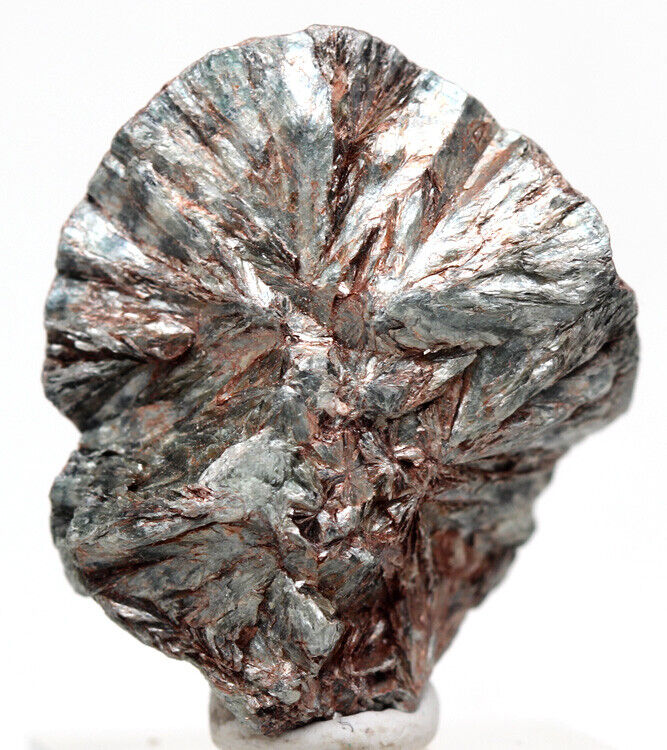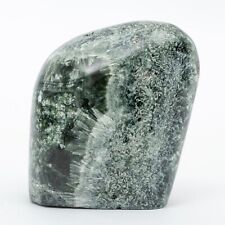CLINOCHLORE SERAPHINITE Chatoyant Crystal Cluster Mineral Specimen RUSSIA For Sale

When you click on links to various merchants on this site and make a purchase, this can result in this site earning a commission. Affiliate programs and affiliations include, but are not limited to, the eBay Partner Network.
CLINOCHLORE SERAPHINITE Chatoyant Crystal Cluster Mineral Specimen RUSSIA:
$31.19
This specimen weighs 12.11 grams. It measures 31 mm x 26 mm x 15 mm.I offer a shipping discount for customers who combine their payments for multiple purchases into one payment!The discount is regular shipping price for the first item and just 50 cents for each additional item!
To be sure you get your shipping discount just make sure all the items you want to purchase are in your cart.
sales you win are added to your cart automatically.
For any \"buy it now\" items or second chance offers, be sure to click the \"add to cart\" button, NOT the \"buy it now\" button.
Onceall of your items are in your cart just pay for them from your cart andthe combined shipping discount should be applied automatically.I offer a money back guarantee on every item I sell.
If you are not 100% happy with your purchase just send me a message to let me know
and I will buy back the item for your full purchase price.Hi there, I am selling this amazing Clinochlore Specimen from Irkutskaya Oblast, Eastern Siberia, Russia.I hope it finds a good home out there, and I am sure it will. If you have any questions, do not hesitate to ask me.Have fun offerding, thanks so much for visiting my sale and have a great day!The following is information about this mineral from wikipedia:
Chlorite groupFrom Wikipedia, the free encyclopediaJump to navigationJump to searchFor the chemistry term, see chlorite.Chlorite groupChloriteUSGOV.jpgGeneralCategory PhyllosilicatesFormula(repeating unit) symbol Chl[1]Crystal system Monoclinic 2/m; with some triclinic polymorphs.IdentificationColor Various shades of green; rarely yellow, red, or white.Crystal habit Foliated masses, scaley aggregates, disseminated flakes.Cleavage Perfect 001Fracture LamellarMohs scale hardness 2–2.5Luster Vitreous, pearly, dullStreak Pale green to greySpecific gravity 2.6–3.3Refractive index 1.57–1.67Other characteristics Folia flexible – not elasticReferences [2][3]The chlorites are a group of phyllosilicate minerals common in low-grade metamorphic rocks and in altered igneous rocks. Greenschist, formed by metamorphism of basalt or other low-silica volcanic rock, typically contains significant amounts of chlorite.
Chlorite minerals show a wide variety of compositions, in which magnesium, iron, aluminium, and silicon substitute for each other in the crystal structure. A complete solid solution series exists between the two most common end members, magnesium-rich clinochlore and iron-rich chamosite. In addition, manganese, zinc, lithium, and calcium species are known. The great range in composition results in considerable variation in physical, optical, and X-ray properties. Similarly, the range of chemical composition allows chlorite group minerals to exist over a wide range of temperature and pressure conditions. For this reason chlorite minerals are ubiquitous minerals within low and medium temperature metamorphic rocks, some igneous rocks, hydrothermal rocks and deeply buried sediments.
The name chlorite is from the Greek chloros (χλωρός), meaning \"green\", in reference to its color. They do not contain the element chlorine, also named from the same Greek root.Contents1 Properties2 Occurrence3 Members of the chlorite group4 Uses5 See also6 References7 Further readingPropertiesChlorite forms blue-green crystals resembling mica. However, while the plates are flexible, they are not elastic like mica, and are less easily pulled apart. Talc is much softer and feels soapy between the fingers.[4][5]
The typical general formula for chlorite is This formula emphasizes the structure of the group, which is described as TOT-O and consists of alternating TOT layers and O layers.[3] The TOT layer (Tetrahedral-Octahedral-Tetrahedral = T-O-T) is often referred to as a talc layer, since talc is composed entirely of stacked TOT layers. The TOT layers of talc are electrically neutral and are bound only by relatively weak van der Waals forces. By contrast, the TOT layers of chlorite contain some aluminium in place of silicon, which gives the layers an overall negative charge. These TOT layers are bound together by positively charged O layers, sometimes called brucite layers. Mica is also composed of aluminium-rich, negatively charged TOT layers, but these are bonded together by individual cations (such as potassium, sodium, or calcium ions) rather than a positively charged brucite layer.[6]
Crystal structure of chlorite viewed along [100] (looking along the layers)Crystal structure of chlorite viewed along [100] (looking along the layers)
Chlorite structure viewed along [001] showing pseudohexagonal structureChlorite structure viewed along [001] showing pseudohexagonal structure
Chlorite is considered a clay mineral. It a nonswelling clay mineral,[7] since water is not adsorbed in the interlayer spaces, and it has a relatively low cation exchange capacity.[8]
Occurrence
Quartz crystal with chlorite inclusions from Minas Gerais, Brazil (size: 4.2 × 3.9 × 3.3 cm)Chlorite is a common mineral, found in metamorphic, igneous, and sedimentary rocks. It is an important rock-forming mineral in low- to medium-grade metamorphic rock formed by metamorphism of mafic or pelitic rock.[9] It is also common in igneous rocks, usually as a secondary mineral, formed by alteration of mafic minerals such as biotite, hornblende, pyroxene, or garnet.[10] The glassy rims of pillow basalt on the ocean floor is often altered to pure chlorite, in part by exchange of chemicals with seawater.[11] The green color of many igneous rocks, slates, and schists is due to fine particles of chlorite disseminated throughout the rock.[10] Chlorite is a common weathering product and is widespread in clay and in sedimentary rock containing clay minerals.[9] Chlorite is found in pelites along with quartz, albite, sericite, and garnet, and is also found in associate with actinolite and epidote.[10]
In his pioneering work on metamorphic facies in the Scottish Highlands, G.M. Barrow identified the chlorite zone as the zone of mildest metamorphism.[12] In modern petrology, chlorite is the diagnostic mineral of the greenschist facies.[10] This facies is characterized by temperatures near 450 °C (840 °F) and pressures near 5 kbar.[13] At higher temperatures, much of the chlorite is destroyed by reactions with either potassium feldspar or phengite mica which produce biotite, muscovite, and quartz. At still higher temperatures, other reactions destroy the remaining chlorite, often with release of water vapor.[14]
Chlorite is one of the most common minerals produced by propylitic alteration by hydrothermal systems, where it occurs in the \"green rock\" environment with epidote, actinolite, albite, hematite, and calcite.[15]Chlorite pseudomorph after garnet from Michigan (size: 3.5 × 3.1 × 2.7 cm)Experiments indicate that chlorite can be stable in peridotite of the Earth\'s mantle above the ocean lithosphere carried down by subduction, and chlorite may even be present in the mantle volume from which island arc magmas are generated.[16][17]
Members of the chlorite group
Chlorite schistBaileychlore IMA1986-056 IMA2000-013 LiAl4(Si3B)O10(OH)8Chamosite year: 1820 (Fe,Mg)5Al(Si3Al)O10(OH)8Clinochlore year: 1851 (Mg,Fe2+)5Al(Si3Al)O10(OH)8Cookeite year: 1866 LiAl4(Si3Al)O10(OH)8Donbassite year: 1940 Al2[Al2.33][Si3AlO10](OH)8Gonyerite year: 1955 (Mn,Mg)5(Fe3+)2Si3O10(OH)8Nimite year: 1968 (Ni,Mg,Al)6(Si,Al)4O10(OH)8Pennantite year: 1946 (Mn5Al)(Si3Al)O10(OH)8Ripidolite chlinochlore var. (Mg,Fe,Al)6(Al,Si)4O10(OH)8Sudoite IMA1966-027 Mg2(Al,Fe)3Si3AlO10(OH)8Clinochlore, pennantite, and chamosite are the most common varieties. Several other sub-varieties have been described. A massive compact variety of clinochlore used as a decorative carving stone is referred to by the trade name seraphinite. It occurs in the Korshunovskoye iron skarn deposit in the Irkutsk Oblast of Eastern Siberia.[18]
UsesChlorite does not have any specific industrial uses of any importance. Some rock types containing chlorite, such as chlorite schist, have minor decorative uses or as construction stone. However, chlorite is a common mineral in clay, which has a vast number of uses.[9]

Related Items:
CLINOCHLORE SERAPHINITE Chatoyant Crystal Cluster Mineral Specimen RUSSIA
$31.19
CLINOCHLORE SERAPHINITE Chatoyant Crystal Cluster Mineral Specimen RUSSIA
$24.99
SERAPHINITE Stalactite freeform stone Clinochlore 10.19 oz healing crystal 8941T
$115.00



